December 18, 2024 · 13 min read
How to Enhance Committee Reporting with Automated Summaries and Analytics

Shaimaa Badawi
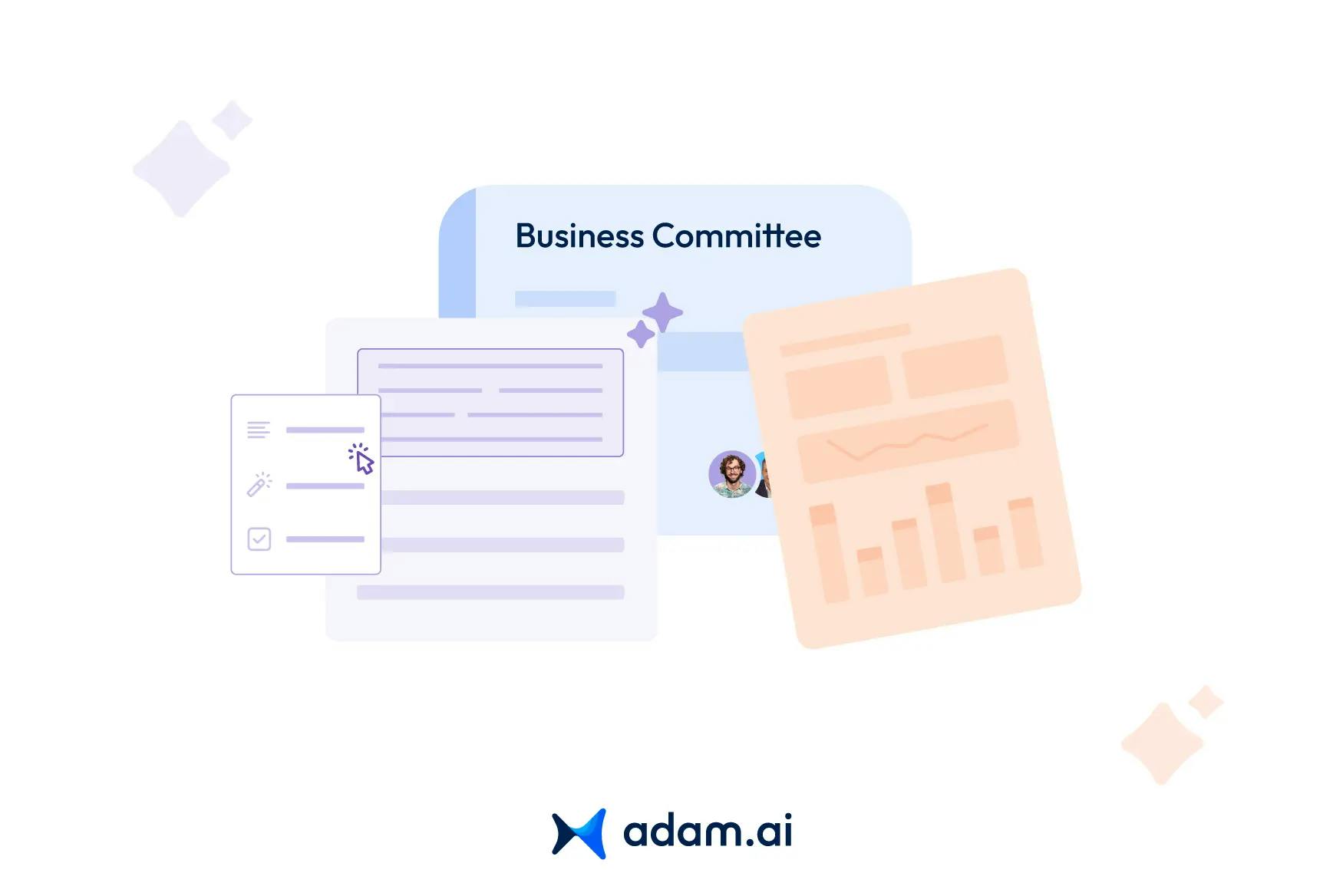
Committees today face mounting challenges in handling complex reporting requirements and delivering actionable insights. With increasing data volumes, tighter compliance demands, and the need for real-time decision-making, finding efficient solutions has become critical. This article explores how automation and advanced analytics can revolutionize committee reporting, improve accuracy, and maximize organizational ROI.
What are the key challenges committees face in reporting and analytics today?
The challenges committees face in reporting and analytics can hinder their ability to make informed, strategic decisions. They are often rooted in traditional methods and the complexities of modern governance. Here’s a breakdown of the key hurdles:
1. Fragmented data sources
Committees frequently rely on multiple systems and platforms for information, such as financial tools, HR systems, and project management software. This fragmentation leads to scattered data, making it difficult to consolidate and analyze information effectively. Setting clear and focused agendas is essential for committees to address challenges like fragmented data and ensure productive discussions.
2. Time-consuming reporting processes
Manual reporting remains the norm in many organizations, where data collection, validation, and analysis require significant time and effort. This not only delays reporting but also limits the ability to provide timely insights during decision-making. Effective task delegation within committees is vital for overcoming time constraints and managing complex reporting workflows.
3. Inconsistent data accuracy
Human errors in manual data handling can lead to inaccuracies, which undermine the credibility of reports. Discrepancies in metrics across departments or committees further compound the issue, leading to conflicting conclusions and decisions.
4. Lack of real-time insights
In fast-paced environments, committees need up-to-date information to respond to changes effectively. Traditional reporting systems, however, often lag behind, offering static data that fails to reflect the current state of affairs. Ad hoc committees often face unique challenges requiring rapid consolidation of data and real-time insights.
5. Compliance and regulatory complexity
Committees, especially in sectors like finance and healthcare, must adhere to stringent reporting standards. Ensuring compliance requires meticulous attention to detail and consumes resources, diverting focus from strategic discussions. Committees such as legal advisory teams can benefit greatly from automation in handling complex compliance and regulatory demands.
6. Insufficient analytics capabilities
Many committees struggle to move beyond basic reporting to advanced analytics. Without tools to uncover patterns, predict trends, or provide actionable insights, their decision-making often remains reactive rather than proactive.
7. Limited accessibility and collaboration
Effective reporting requires input and collaboration across departments. However, a lack of centralized platforms often results in silos, where committee members can’t access or share critical information efficiently.
8. Overwhelming volume of data
The exponential growth of data presents a paradox for committees: while there is more information available than ever, sifting through it to find what’s relevant can be daunting, leading to analysis paralysis. Standing committees benefit from automated systems that support consistent reporting across recurring tasks.
How do automated summaries transform committee reporting?
Automated summaries revolutionize committee reporting by addressing inefficiencies in traditional processes and enabling committees to work smarter, not harder. Here's how they transform reporting:
1. Streamlining information consolidation
Automated summaries quickly compile data from multiple sources into cohesive, digestible reports. Instead of manually sifting through lengthy documents, committees receive concise summaries that highlight the most critical information, saving time and ensuring focus on what matters.
2. Enhancing accuracy and consistency
By eliminating manual entry and interpretation errors, automated summaries provide consistent and accurate data. This reliability is crucial for committees when evaluating performance metrics, reviewing compliance requirements, or making strategic decisions.
3. Providing real-time insights
Automation tools process data in real-time, delivering up-to-date insights to committees. This capability is particularly vital for responding to fast-evolving situations or monitoring ongoing projects, enabling timely and informed decisions.
4. Boosting meeting efficiency
With key points already summarized and highlighted, committee members can spend less time reviewing lengthy reports and more time discussing actionable outcomes. Automated summaries also ensure all members are aligned on the same data, improving collaboration. Efficient committee meetings are essential for aligning stakeholders and fostering strategic focus.
5. Enabling advanced analytics
Automated systems often incorporate analytics to add depth to summaries. They can identify trends, flag anomalies, and even offer predictive insights, giving committees a proactive edge in addressing challenges and capitalizing on opportunities.
6. Reducing reporting overheads
By automating repetitive tasks like data extraction, formatting, and summarization, committees save significant time and resources. This efficiency allows organizations to allocate effort toward strategic initiatives rather than operational reporting.
7. Improving accessibility and communication
Automated summaries can be tailored for different stakeholders, providing customized reports that meet the specific needs of board members, project managers, or external regulators. This adaptability ensures clear and effective communication across the organization.
8. Enhancing governance and accountability
With automated summaries, committees can document decisions and action items more effectively. This transparency reinforces accountability and improves governance, creating a clear trail of insights and resolutions.
How does AI-powered reporting enhance accuracy and efficiency?
AI-powered reporting transforms committee operations by addressing critical challenges in accuracy, efficiency, and real-time decision-making. Here's how it achieves this:
1. Enhancing accuracy
- Data validation and consistency: AI systems automatically detect and correct inconsistencies, errors, or duplications in data. This ensures that reports are based on accurate and reliable information.
- Reducing human error: Manual processes often introduce errors during data entry or analysis. AI eliminates these vulnerabilities by automating repetitive tasks, producing error-free outputs.
- Contextual insights: AI-powered tools interpret data within its context, improving the relevance and precision of metrics presented in reports. For instance, they highlight anomalies in trends that might otherwise be overlooked.
2. Boosting efficiency
- Automating repetitive tasks: AI streamlines time-consuming processes like data collection, cleaning, and formatting, freeing committee members to focus on strategic analysis.
- Simplifying complex reporting: By generating summaries, dashboards, and visualizations automatically, AI reduces the workload associated with creating detailed reports.
- Faster turnaround times: Reports that previously took hours or days can now be generated in minutes, keeping pace with the demands of dynamic organizational environments.
3. Driving real-time decision-making
- Instant access to insights: AI-powered tools process and analyze data as it becomes available, ensuring that committees work with the most current information.
- Proactive alerts: AI can identify trends or risks early, alerting committees to take preemptive action. For example, a sudden drop in performance metrics might trigger an automated notification, allowing swift intervention.
- Scenario analysis and predictions: Using machine learning, AI can simulate various scenarios and provide predictive insights, helping committees prepare for potential outcomes and make data-driven decisions.
4. Improving collaboration and communication
- Centralized dashboards: AI integrates data from multiple sources into a single platform, making it easier for committees to collaborate and access insights collectively.
- Tailored reporting: AI customizes reports to suit different stakeholders’ needs, ensuring everyone receives relevant information for their role, whether they are board members, project managers, or external regulators.
5. Fostering strategic focus
By handling operational aspects of reporting, AI enables committees to spend more time on high-level strategic discussions. This shift from data preparation to insight-driven action enhances the committee’s role in achieving organizational goals.
What industries benefit most from automated committee reporting and analytics?
Automated committee reporting and analytics bring transformative benefits across various industries, particularly those reliant on complex governance structures, regulatory compliance, and data-driven decision-making. Here's how specific industries gain the most:
1. Finance and banking
- Regulatory compliance: Financial institutions must adhere to strict regulations and provide detailed reports to stakeholders and regulators. Automation ensures accurate, timely, and auditable reports, reducing the risk of non-compliance.
- Risk management: AI-powered analytics help identify potential financial risks, anomalies, or fraud, enabling proactive decision-making.
- Efficiency gains: Streamlining reporting processes saves time, allowing financial committees to focus on strategic goals like investment opportunities and portfolio management.
2. Healthcare
- Patient data integration: Hospitals and healthcare committees manage vast amounts of patient and operational data. Automated reporting consolidates this information to improve decision-making on resource allocation and patient outcomes.
- Compliance with standards: Meeting healthcare regulations like HIPAA or other local standards becomes more manageable with accurate and automated reporting tools.
- Performance tracking: Analytics enable committees to assess key performance indicators (KPIs) like patient satisfaction, treatment effectiveness, and operational efficiency. DEI committees can leverage advanced analytics to measure and enhance diversity and inclusion initiatives.
3. Education
- Governance and accreditation: Educational institutions benefit from streamlined reporting for accreditation bodies and internal governance boards.
- Data-driven decisions: Analytics support committees in evaluating student performance, funding allocation, and faculty management based on accurate data.
- Strategic planning: Automation simplifies the assessment of enrollment trends, budget utilization, and program effectiveness.
4. Government and public sector
- Transparency and accountability: Automated reporting enhances transparency in decision-making processes, helping governments meet public and legislative scrutiny. Government committees have increasingly relied on AI documentation tools to streamline reporting and ensure transparency.
- Improved resource management: Committees use analytics to optimize resource allocation, track policy implementation, and monitor infrastructure projects.
- Compliance: Real-time reporting ensures adherence to evolving legal and regulatory requirements.
5. IT and technology
- Project oversight: Automated reporting helps tech committees manage project timelines, budget adherence, and resource utilization.
- Agility in decision-making: Analytics provide real-time data on product performance and innovation strategies, empowering committees to adapt swiftly in dynamic markets.
- Risk and incident management: Automation streamlines reporting on cybersecurity incidents and compliance with data protection regulations.
6. Energy and utilities
- Operational efficiency: Committees benefit from analytics that track energy production, consumption, and waste, enabling smarter resource use.
- Compliance with environmental standards: Automated reporting supports adherence to regulations related to emissions and sustainability goals.
- Stakeholder engagement: Clear, concise reports ensure stakeholders are informed about the organization’s environmental and financial performance.
7. Manufacturing and supply chain
- Process optimization: Committees monitor production efficiency, supply chain resilience, and quality control using automated insights.
- Cost reduction: Analytics help identify inefficiencies, saving costs across operations.
- Sustainability goals: Real-time reporting supports sustainability committees in tracking progress on carbon reduction and waste management initiatives.
What features should enterprises look for in an automated committee reporting platform?
When selecting an automated committee reporting platform, enterprises should prioritize features that enhance efficiency, accuracy, and decision-making capabilities while aligning with their specific needs. Here are the essential features to look for:
1. Data integration and centralization
- The platform should seamlessly integrate with existing tools and data sources, such as financial systems, project management software, and CRM platforms.
- Centralized dashboards enable committees to access consolidated data from multiple departments or sources in one place, improving collaboration and efficiency.
2. Customizable reports and dashboards
- Flexibility to create tailored reports and dashboards based on the specific needs of different committees or stakeholders.
- The ability to customize metrics, filters, and visualization styles ensures reports are relevant and actionable.
3. Real-time data processing
- Real-time data updates allow committees to make informed decisions quickly, especially in fast-paced environments like finance or IT.
- Instant alerts for anomalies or key metric changes keep committees proactive.
4. Advanced analytics and insights
- Tools for trend analysis, predictive analytics, and anomaly detection to provide actionable insights rather than raw data.
- AI-powered features that offer recommendations, highlight risks, or suggest opportunities for improvement.
5. Compliance and governance tools
- Built-in compliance features that align with industry-specific regulations, such as GDPR, HIPAA, or Sarbanes-Oxley.
- Audit trails and data security features ensure accountability and confidentiality.
6. Collaboration and communication features
- Role-based access controls that allow different members to contribute or view reports as needed. Nominating committees play a crucial role in ensuring leadership alignment with organizational goals through structured processes.
- Integrated communication tools or links to video conferencing and messaging platforms to enhance collaboration during meetings.
7. Ease of use
- An intuitive interface that requires minimal training, enabling non-technical users to generate and interpret reports without relying on IT teams.
- Drag-and-drop functionality, pre-built templates, and guided workflows simplify the reporting process.
8. Automation capabilities
- Automated data collection, transformation, and report generation to reduce manual effort and eliminate errors.
- Scheduled reporting options to ensure timely delivery of recurring reports.
9. Scalability and adaptability
- The platform should grow with the organization, accommodating increased data volumes or additional users as needed.
- Support for diverse use cases, from operational monitoring to strategic decision-making.
10. Integration with AI and machine learning
- AI-driven features for intelligent summaries, sentiment analysis, and contextual insights.
- Machine learning algorithms that adapt to committee preferences and improve report relevance over time.
11. Mobile accessibility
- Mobile-friendly interfaces or dedicated apps ensure committee members can access reports and dashboards on the go.
- Offline access for reviewing critical information during travel or when connectivity is limited.
How can organizations measure ROI from automated committee reporting and analytics solutions?
Measuring ROI from automated committee reporting and analytics solutions involves evaluating both tangible and intangible benefits. Organizations can assess their return on investment by focusing on key metrics that reflect efficiency, cost savings, and strategic impact. Here’s how they can approach this:
1. Assess time savings
- Metric: Hours saved by automating repetitive reporting tasks like data collection, validation, and formatting.
- Impact on ROI: Reduced manual effort translates directly into cost savings, allowing employees to focus on higher-value activities like analysis and strategic planning.
2. Quantify cost reductions
- Metric: Decrease in expenses associated with labor-intensive manual reporting processes.
- Impact on ROI: Savings from reduced dependency on external consultants, overtime pay, or additional hires to manage reporting workloads.
3. Evaluate accuracy and error reduction
- Metric: Decrease in errors or inconsistencies in reports after implementing automated solutions.
- Impact on ROI: Accurate data minimizes financial and reputational risks, particularly in compliance-heavy industries like finance or healthcare.
4. Track speed and efficiency
- Metric: Time taken to generate reports before and after automation.
- Impact on ROI: Faster report turnaround enhances responsiveness to market changes, project updates, or regulatory requirements.
5. Analyze decision-making impact
- Metric: Number of strategic decisions influenced by insights derived from analytics.
- Impact on ROI: Advanced analytics provide committees with actionable insights, improving operational performance and long-term strategic outcomes.
6. Assess stakeholder satisfaction
- Metric: Feedback scores or satisfaction ratings from stakeholders and committee members on reporting processes.
- Impact on ROI: Improved satisfaction reflects better collaboration, transparency, and communication, boosting organizational trust and cohesion.
7. Calculate compliance improvements
- Metric: Number of compliance violations or audit findings before and after adopting automated solutions.
- Impact on ROI: Automation ensures adherence to regulations, reducing penalties and enhancing governance.
8. Evaluate scalability
- Metric: Ability to handle increased data volumes or additional committee requirements without a proportional increase in costs.
- Impact on ROI: Scalable solutions prevent future costs associated with upgrading or expanding reporting infrastructure.
9. Examine productivity gains
- Metric: Percentage increase in tasks completed or goals achieved by committees using automated reporting tools.
- Impact on ROI: Enhanced productivity allows committees to allocate more time to strategic discussions and value-driven activities.
10. Track strategic outcomes
- Metric: Tangible business results, such as improved project completion rates, cost savings in operations, or higher revenue linked to better decisions.
- Impact on ROI: The alignment of analytics with organizational goals demonstrates the strategic value of automation.
How does adam.ai maximize ROI from committee reporting?
adam.ai simplifies committee reporting and analytics by addressing common challenges and supporting efficiency, accuracy, and informed decision-making. Here’s how:
- Agenda management: adam.ai helps create focused agendas that prioritize stakeholder concerns and key discussion points. By structuring meetings around clear objectives, it ensures that important topics are addressed in a way that fosters meaningful engagement.
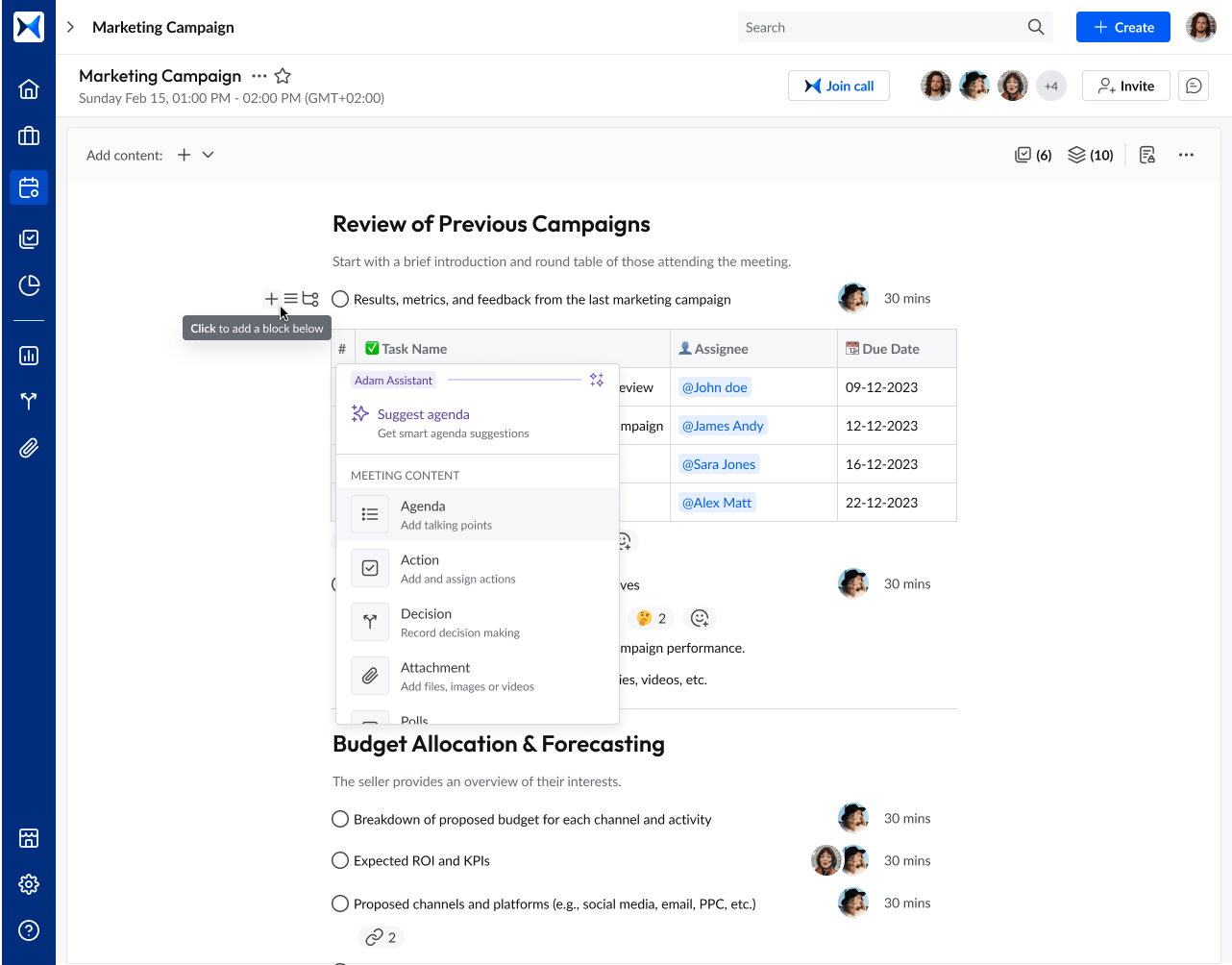
- Action tracking: adam.ai ensures accountability by linking action items to specific meetings and assigning owners to tasks. This feature enables committees to track progress and follow up efficiently, turning decisions into measurable outcomes.
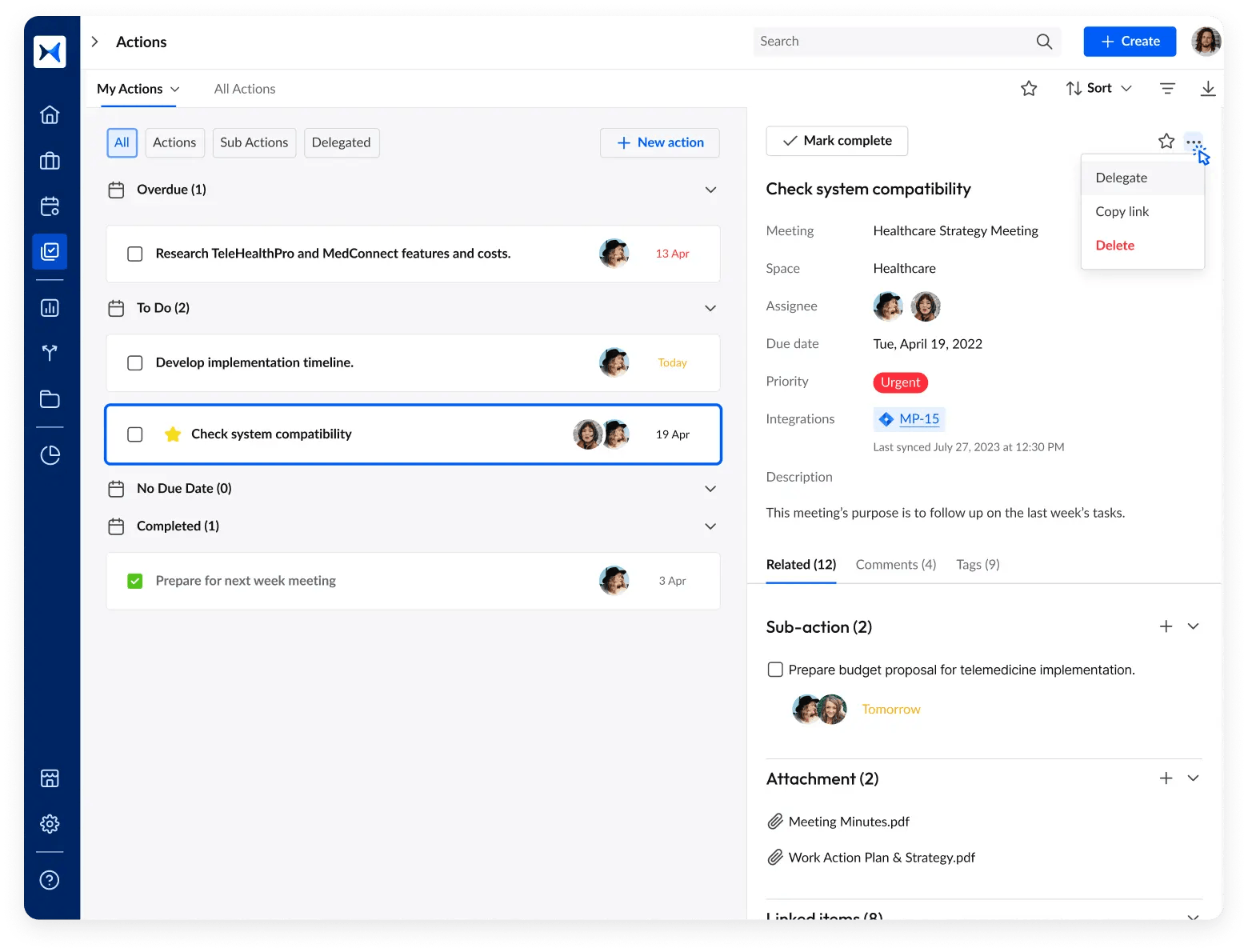
- Meeting minutes: adam.ai automates the process of recording and organizing meeting discussions and decisions. With professional-quality minutes generated instantly, committees can improve compliance and ensure that key information is accessible for future reference.
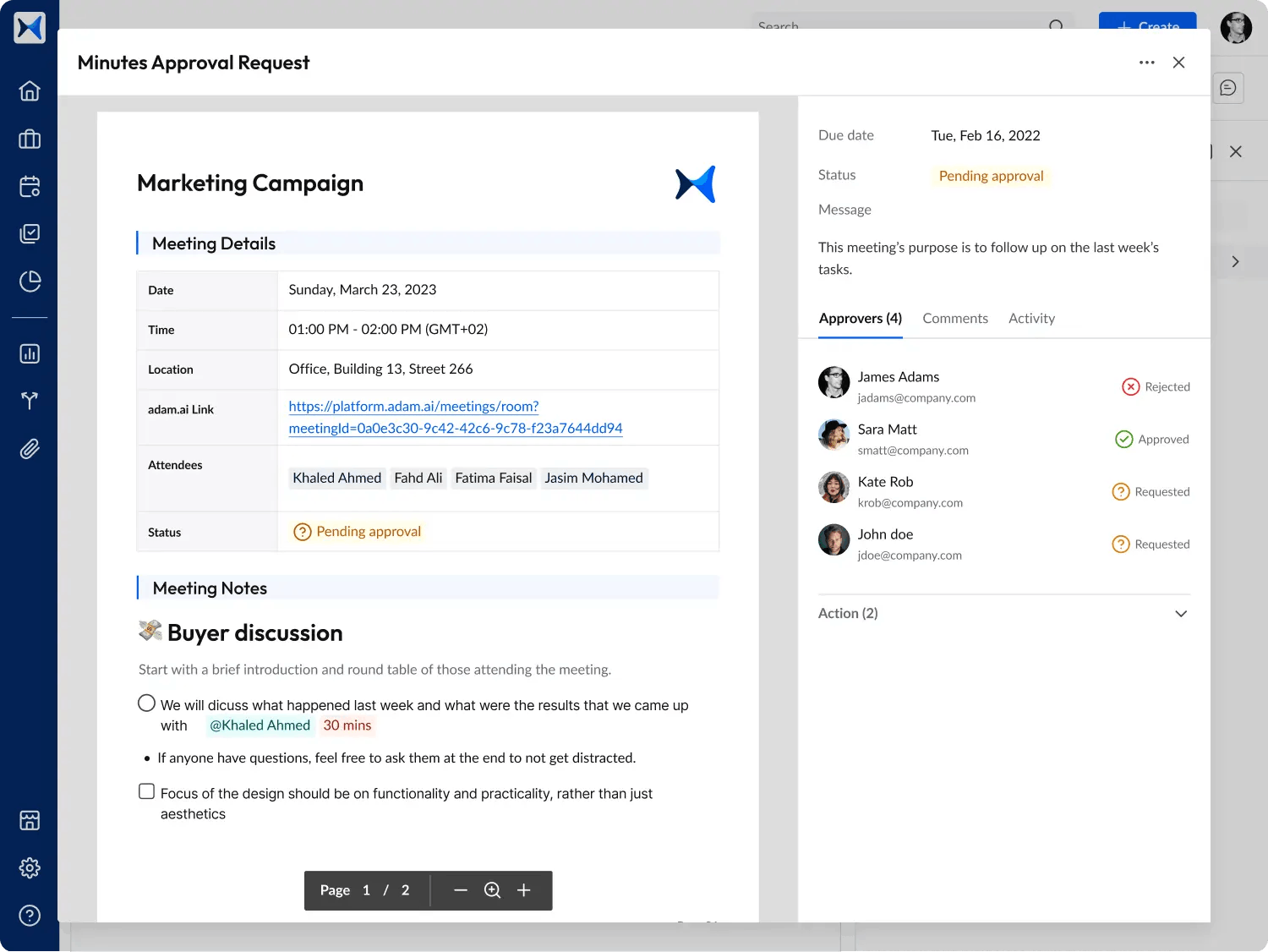
- Multi-space management: adam.ai centralizes data from multiple committees and departments, enabling seamless collaboration across teams. By managing spaces separately yet cohesively, organizations can scale operations without compromising efficiency.
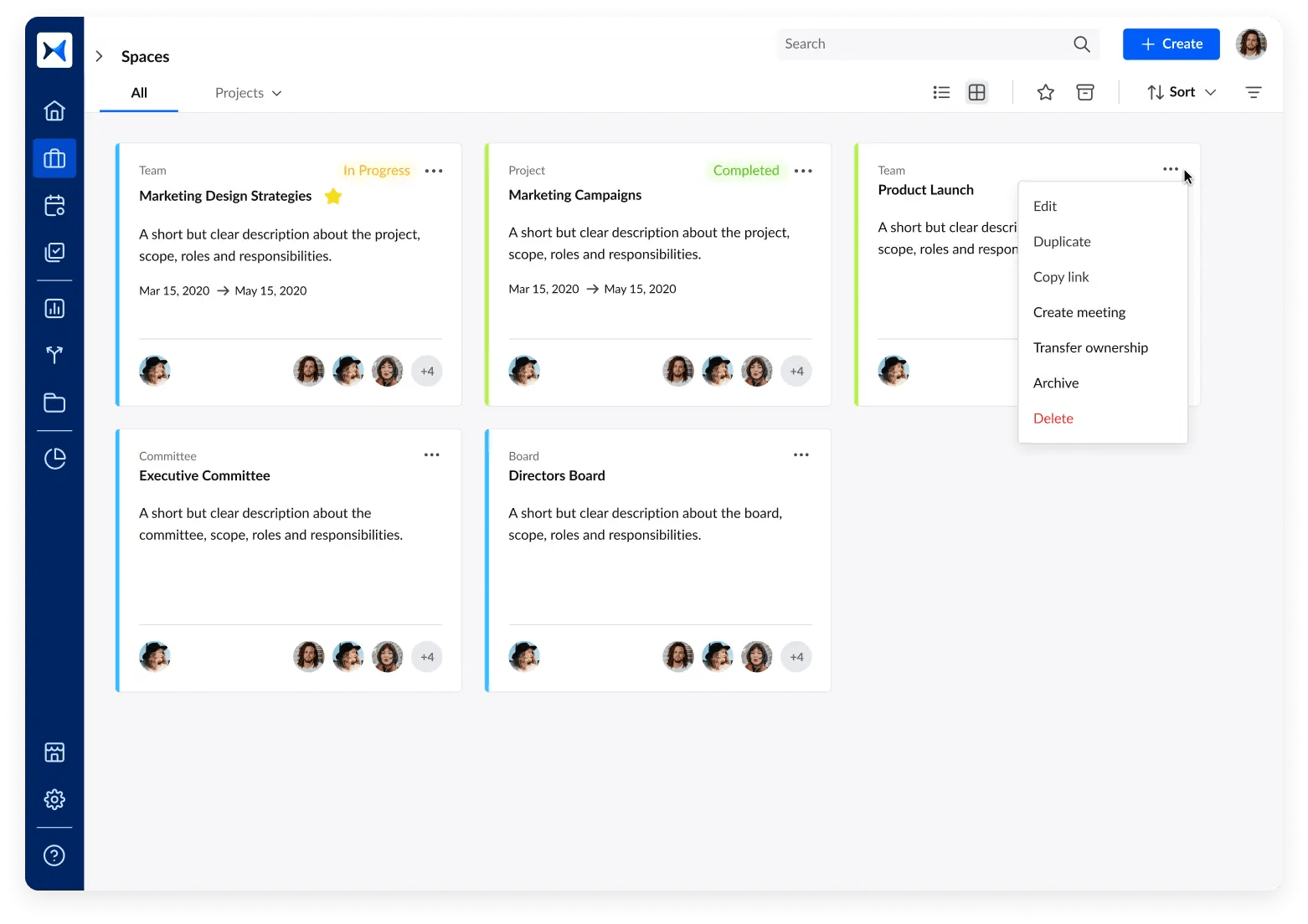
- Analytical dashboards: adam.ai provides real-time insights through intuitive dashboards that track meeting outcomes and performance metrics. Committees can use these insights to make data-driven decisions that align with strategic goals.
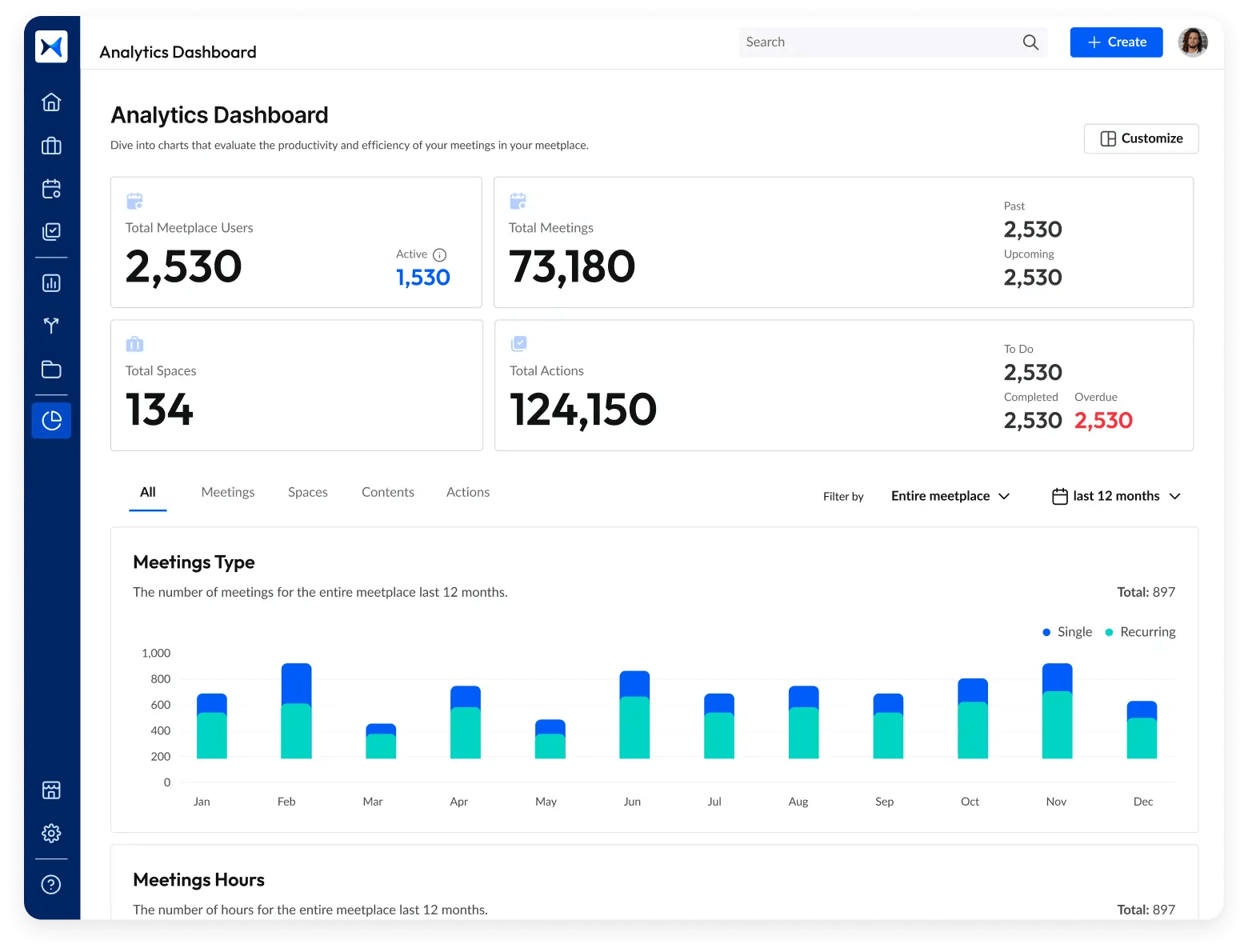
Transform how you conduct critical meetings—From meticulous preparation to effective execution and insightful follow-up, adam.ai integrates comprehensive analytics, full customization, and intuitive interfaces with powerful meeting management tools.
Easy onboarding. Enterprise-grade security. 24/7 dedicated support.
The bottom line
Leveraging modern tools for committee reporting is no longer optional; it's a strategic necessity. By embracing automation and analytics, organizations can attain greater efficiency, enhance decision-making, and stay ahead in a competitive landscape.
And while there may be multiple solutions available, here is why adam.ai is the meeting management software platform you can trust:
- adam.ai is one of Atlassian Ventures' portfolio companies.
- In the meeting management software category on G2, adam.ai has been ranked a leader and a high performer for successive quarters in the past years.
- adam.ai has been included in the Forrester Report in the AI-enabled meeting technology landscape.
- adam.ai is trusted and used by powerful teams and organizations worldwide for all types of critical meetings, like board, committee, project management, and business development meetings.
- And most importantly, adam.ai integrates with your existing workflow, is SOC2 compliant, provides dedicated support and success, and has a free trial option.
Subscribe to adam.ai blog
Stay ahead with the latest insights—get our newest blog posts, tips, and updates sent straight to your inbox.